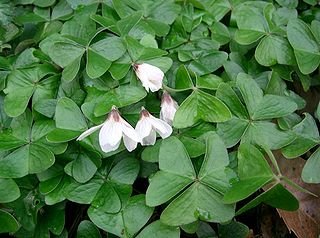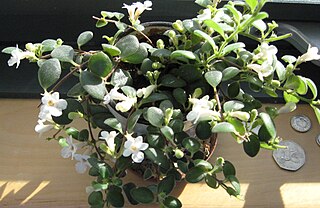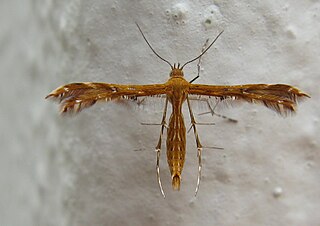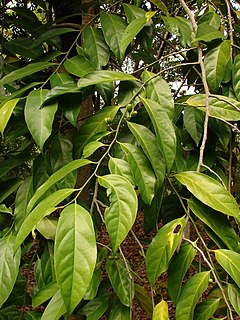
The horned puffin is an auk, similar in appearance to the Atlantic puffin. It is a pelagic seabird that feeds primarily by diving for fish. It nests in colonies, often with other auks.

Oxalis is a large genus of flowering plants in the wood-sorrel family Oxalidaceae comprising about 570 species. The genus occurs throughout most of the world, except for the polar areas; species diversity is particularly rich in tropical Brazil, Mexico and South Africa.

Oxalis corniculata, the creeping woodsorrel, also called procumbent yellow sorrel or sleeping beauty, resembles the common yellow woodsorrel, Oxalis stricta. It is a somewhat delicate-appearing, low-growing, herbaceous plant in the family Oxalidaceae. It has a narrow, creeping stem that readily roots at the nodes. The trifoliate leaves are subdivided into three rounded leaflets and resemble a clover in shape. Some varieties have green leaves, while others, like Oxalis corniculata var. atropurpurea, have purple. The leaves have inconspicuous stipules at the base of each petiole.

Sebastiania is a genus of flowering plants in the family Euphorbiaceae first described in 1821. It is native to North and South America from Arizona and the West Indies south to Uruguay.

Stillingia is a plant genus of the family Euphorbiaceae, first described for modern science as a genus in 1767. The genus is native to Latin America, the southern United States, and various islands in the Pacific and Indian Oceans. Toothleaf is a common name for plants in this genus.

Rhizophora is a genus of tropical mangrove trees, sometimes collectively called true mangroves. The most notable species is the red mangrove but some other species and a few natural hybrids are known. Rhizophora species generally live in intertidal zones which are inundated daily by the ocean. They exhibit a number of adaptations to this environment, including -pneutomatophores that elevate the plants above the water and allow them to respire oxygen even while their lower roots are submerged, and a cytological molecular "pump" mechanism that allows them to remove excess salts from their cells. The generic name is derived from the Greek words ριζα (rhiza), meaning "root," and φορος (phoros), meaning "bearing," referring to the stilt-roots.
Yellow woodsorrel may refer to any member of the woodsorrel genus (Oxalis) with yellow flowers, but especially:

Corniculate, an Anglicisation of the Latin diminutives corniculata, corniculatum, and corniculatus, describes an object possessing hornlike extensions. The root is Latin cornu = "horn". The term is used to describe the shape of the corniculate cartilages of the larynx. The horned puffin is named for its distinctive horn-like coloration. Likewise Oxalis corniculata is named for its two erect capsules, which resemble little horns, and the bird's-foot trefoil Lotus corniculatus and goat's horn mangrove Aegiceras corniculatum are named for their horn-shaped fruits.
Guzmania corniculata is a species of plant in the Bromeliaceae family. It is endemic to Ecuador. Its natural habitat is subtropical or tropical moist lowland forests. It is threatened by habitat loss.

Palicourea is a plant genus in the family Rubiaceae. It contains about 200 species, which range in habit from shrubs to small trees, and is distributed throughout the New World tropics.
Palicourea corniculata is a species of plant in the Rubiaceae family. It is endemic to Ecuador.

Codonanthe is a New World genus, consisting of a dozen or more species of evergreen epiphytic compact creeping vines with rooting along their stems, and scandent herbs or subshrubs with woody, upright stems from Brazil, Guiana, Central America and West Indies. In its own habitat, the plant usually grows in association with tree ant nests. The botanical name comes from the Greek for bellflower. Small red stems held flat or hanging, about 30 cm long, with pairs of relatively succulent, hard-surfaced and small round dark foliage. Delicate, pale-pink to white, bell-shaped flowers grow from the leaf axil, either single or in group and always produce in a large number. Flower tube has 2 lips, each with 2 and 3 lobes; which may be white, pink, lilac to deep purple with yellow throat. These delightful waxy flowers are strongly scented. Colorful berry-like fruits appear after flowering. Seeds look like ant eggs or larvae, which are carried to the nest by ants and inserted into the fertile nest wall where they germinate. Seeds that germinate outside a nest tend to grow more slowly.
Aulacogenia is a genus within the subfamily Stenopodainae of Reduviidae. 19 species have been described, including 5 from China.

Stenodacma wahlbergi is a moth of the family Pterophoridae described by Philipp Christoph Zeller in 1851. It is known from Japan, China, Saudi Arabia, Iran, Sri Lanka, India, Central, East and South Africa, St. Helena, Mauritius, the Seychelles and Rodriguez Island. It has recently been recorded from Vietnam. Records for Australia were based on synonymisation with Stenodacma pyrrhodes.
Alasea is a genus of moths in the family Choreutidae, containing only one species, Alasea corniculata, which is known from Costa Rica.
Furona is a genus of longhorn beetles of the subfamily Lamiinae, containing the following species:
Corallina elegans is a species of red algae in the family Corallinaceae from the Mediterranean Sean and the North Atlantic Ocean.
Furona corniculata is a species of beetle in the family Cerambycidae. It was described by Henry Walter Bates in 1885. It is known from Panama and Honduras.

Megalorchestia is a genus of sand-hoppers in the family Talitridae. The genus was erected by the German naturalist Johann Friedrich von Brandt in 1851 and the type species is Megalorchestia californiana.
Megalorchestia corniculata is a species of beach hopper in the family Talitridae.














